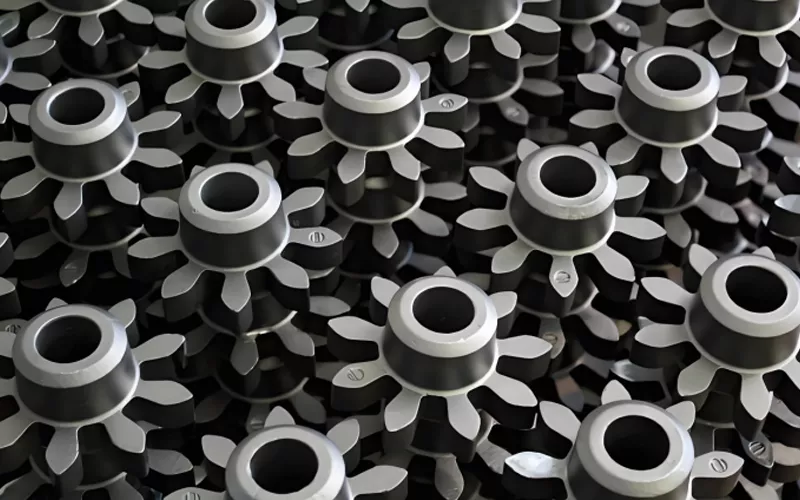What is Sintered Silicon Carbide?
Sintered silicon carbide is an advanced engineering ceramic material. It is not only a common grinding material, but also an indispensable key material in high-tech fields such as semiconductors and aviation. Its outstanding performance makes it one of the preferred materials for high temperature resistance, corrosion resistance and wear resistance applications.
Usually, it is made by sintering silicon carbide powder at a high temperature of 2000℃ to 2600℃ in a vacuum or inert environment.

Through high-temperature sintering, the particles of silicon carbide powder will bond together and form a dense structure (achieving a density of more than 99%), giving it higher density and mechanical strength, and the ability to withstand greater pressure and stress.
Characteristics of Sintered Silicon Carbide
Wear and Abrasion Resistance
Sintered carbide has excellent wear resistance. Even under harsh working conditions such as high-speed friction, high pressure and particle abrasion, sintered silicon carbide can maintain extremely low wear rate and stable dimensional accuracy. It can be used in high-speed running parts such as mechanical seals, bearings and pump bodies.
Corrosion Resistant Properties
Sintered silicon carbide has strong corrosion resistance. In various corrosive media such as strong acids, strong alkali, organic solvents, etc., it can be stored stably by its strong corrosion resistance. It can remain stable in various corrosive media such as strong acids, strong alkalis, organic solvents, etc. Sintered silicon carbide has a wide range of applications in some chemical, petroleum and papermaking industries.
Temperature Strength and Creep Resistance
One of the most notable features of sintered silicon carbide is its excellent high-temperature performance. At extremely high temperatures close to 1750°C, it can still maintain strength levels comparable to those at room temperature. More importantly, due to its high elastic modulus and crystal structure, sintered silicon carbide has extremely strong creep resistance in high-temperature and high-pressure environments, and almost no creep deformation occurs even under continuous stress, making it the preferred material for high-temperature structural parts and hot-end components.
Thermal Shock Performance
The thermal shock resistance of sintered silicon carbide is also excellent. This is a structure where a variety of excellent properties work together. High thermal conductivity (125 W/mK) allows it to conduct heat quickly and evenly, which effectively prevents the generation of local stress; while the low expansion coefficient (4.0×10⁻⁶/℃) can minimize the dimensional changes caused by temperature.
Excellent thermal shock resistance makes sintered silicon carbide more reliable in environments with rapid temperature changes such as high-temperature furnaces and heat exchangers.
Other Types of Silicon Carbide
Compared with sintered silicon carbide, although reaction-bonded silicon carbide (RBSiC) has lower production costs and smaller dimensional shrinkage, its mechanical strength and corrosion resistance are relatively low. The typical density of reaction-bonded silicon carbide is 3.06 g/cm³, and the maximum operating temperature is around 1300°C.
CVD silicon carbide is known for its ultra-high purity (>99.9995%) and is particularly suitable for the demanding requirements of the semiconductor industry. However, its production cost is high and it is limited in the manufacture of large, complex-shaped components.
Liquid phase sintered silicon carbide can be densified at a lower temperature and have better mechanical properties by adding sintering aids, but its high temperature performance is relatively poor.
Advantages and Limitations of Sintered SiC
Strengths:
- It has excellent high temperature and mechanical properties and can maintain good stability at high temperatures (1600°C)
- Corrosion resistance
- High hardness and wear resistance
- Excellent thermal conductivity and strong resistance to thermal shock
limitation:
- The cost of production is high
- The processing is difficult and requires some special processing equipment
- The toughness of sintered silicon carbide will be relatively low
Applications of Sintered Silicon Carbide
High Temperature Applications
Sintered silicon carbide has excellent high-temperature strength and oxidation resistance. It can still work stably even at high temperatures of 1600°C. It can be used to manufacture heat exchangers, burner components, kiln accessories and other applications.
Industrial Applications
The excellent wear resistance and hardness of sintered silicon carbide are very suitable for applications in some wear-resistant fields, such as mechanical seals, bearings and pump body parts. Its excellent performance can ensure long-term use and has good dimensional stability.
Chemical Applications
Sintered silicon carbide has excellent corrosion resistance and can handle various strong acids, strong alkalis and various corrosive media. It is an ideal material choice for the chemical industry. It can be seen in some chemical pump parts, heat exchangers, reactor linings, etc.
Semiconductor Applications
In the semiconductor industry, sintered silicon carbide is extremely critical. It is an indispensable key material in semiconductor manufacturing equipment. It can manufacture wafer carriers, process chamber components, heat treatment devices, etc. The properties of sintered silicon carbide perfectly fit these applications.
Automotive Aerospace
The automotive and aerospace industries are extremely demanding in terms of material selection, requiring strong mechanical and thermal properties, and sintered silicon carbide meets these requirements. It can be used in high-temperature and high-speed running parts such as braking systems, engine components, and turbochargers in automobiles; and in aerospace, it is mainly used in key parts such as engine hot end components and heat protection systems.
Conclusion
With the continuous optimization and innovation of manufacturing processes, the performance of sintered silicon carbide will continue to improve and its application scope will become increasingly larger. At the same time, it also plays an irreplaceable role in modern industry.